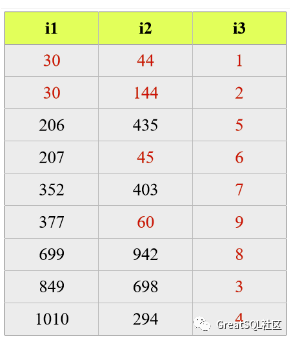3.联合索引、覆盖索引及最左匹配原则|MySQL索引学习
导语
在数据检索的过程中,经常会有多个列的匹配需求,今天介绍下联合索引的使用以及最左匹配原则的案例。
最左匹配原则作用在联合索引中,假如表中有一个联合索引(tcol01,tcol02,tcol03),只有当SQL使用到tcol01、tcol02索引的前提下,tcol03的索引才会被使用;同理只有tcol01的索引被使用的前提下,tcol02的索引才会被使用。
下面我们来列举几个例子来说明。
步骤
使用 mysql_random_data_load 创建测试数据
建库和建表
CREATE DATABASE IF NOT EXISTS test;
CREATE TABLE `test`.`t3` (
`id` int(11) NOT NULL AUTO_INCREMENT,
`tcol01` tinyint(4) DEFAULT NULL,
`tcol02` smallint(6) DEFAULT NULL,
`tcol03` mediumint(9) DEFAULT NULL,
`tcol04` int(11) DEFAULT NULL,
`tcol05` bigint(20) DEFAULT NULL,
`tcol06` float DEFAULT NULL,
`tcol07` double DEFAULT NULL,
`tcol08` decimal(10,2) DEFAULT NULL,
`tcol09` date DEFAULT NULL,
`tcol10` datetime DEFAULT NULL,
`tcol11` timestamp NOT NULL DEFAULT CURRENT_TIMESTAMP ON UPDATE CURRENT_TIMESTAMP,
`tcol12` time DEFAULT NULL,
`tcol13` year(4) DEFAULT NULL,
`tcol14` varchar(100) DEFAULT NULL,
`tcol15` char(2) DEFAULT NULL,
`tcol16` blob,
`tcol17` text,
`tcol18` mediumtext,
`tcol19` mediumblob,
`tcol20` longblob,
`tcol21` longtext,
`tcol22` mediumtext,
`tcol23` varchar(3) DEFAULT NULL,
`tcol24` varbinary(10) DEFAULT NULL,
`tcol25` enum('a','b','c') DEFAULT NULL,
`tcol26` set('red','green','blue') DEFAULT NULL,
`tcol27` float(5,3) DEFAULT NULL,
`tcol28` double(4,2) DEFAULT NULL,
PRIMARY KEY (`id`)
) ENGINE=InnoDB;建联合索引
CREATE INDEX idx_tcol123 ON t1(`tcol01`,`tcol02`,`tcol03`);写入100w条测试数据
./mysql_random_data_load test t1 1000000 --user=root --password=GreatSQL --config-file=/data/GreatSQL/my.cnf联合索引数据存储方式
先对索引中第一列的数据进行排序,而后在满足第一列数据排序的前提下,再对第二列数据进行排序,以此类推。
如下图:

索引最左原则案例
情况1:三个索引都能使用上
实验1:仅有where子句
# 三个条件都使用上,优化器可以自己调整顺序满足索引要求
[root@GreatSQL][test]>explain SELECT /* NO_CACHE */ * FROM t1 WHERE tcol02=167 AND tcol03=202019 AND tcol01=1;
+----+-------------+-------+------------+------+---------------+-------------+---------+-------------------+------+----------+-------+
| id | select_type | table | partitions | type | possible_keys | key | key_len | ref | rows | filtered | Extra |
+----+-------------+-------+------------+------+---------------+-------------+---------+-------------------+------+----------+-------+
| 1 | SIMPLE | t1 | NULL | ref | idx_tcol123 | idx_tcol123 | 9 | const,const,const | 1 | 100.00 | NULL |
+----+-------------+-------+------------+------+---------------+-------------+---------+-------------------+------+----------+-------+
1 row in set, 1 warning (0.11 sec)
[root@GreatSQL][test]>explain SELECT /* NO_CACHE */ * FROM t1 WHERE tcol02=167 AND tcol01=1 AND tcol03=202019 ;
+----+-------------+-------+------------+------+---------------+-------------+---------+-------------------+------+----------+-------+
| id | select_type | table | partitions | type | possible_keys | key | key_len | ref | rows | filtered | Extra |
+----+-------------+-------+------------+------+---------------+-------------+---------+-------------------+------+----------+-------+
| 1 | SIMPLE | t1 | NULL | ref | idx_tcol123 | idx_tcol123 | 9 | const,const,const | 1 | 100.00 | NULL |
+----+-------------+-------+------------+------+---------------+-------------+---------+-------------------+------+----------+-------+实验2:WHERE 加 order by子句
# 解析出来只有用到tcol01,tcol02索引,由于`explain`不会统计`order by`索引的信息,所有看起来`key_len`长度只有5;当tcol03倒序的时候就会用到`Backward index scan`功能
[test]>explain SELECT /* NO_CACHE */ * FROM t1 WHERE tcol01=1 AND tcol02=167 order by tcol03;
+----+-------------+-------+------------+------+---------------+-------------+---------+-------------+------+----------+-------+
| id | select_type | table | partitions | type | possible_keys | key | key_len | ref | rows | filtered | Extra |
+----+-------------+-------+------------+------+---------------+-------------+---------+-------------+------+----------+-------+
| 1 | SIMPLE | t1 | NULL | ref | idx_tcol123 | idx_tcol123 | 5 | const,const | 269 | 100.00 | NULL |
+----+-------------+-------+------------+------+---------------+-------------+---------+-------------+------+----------+-------+
1 row in set, 1 warning (0.01 sec)
[test]>explain SELECT /* NO_CACHE */ * FROM t1 WHERE tcol01=1 AND tcol02=167 order by tcol03 desc;
+----+-------------+-------+------------+------+---------------+-------------+---------+-------------+------+----------+---------------------+
| id | select_type | table | partitions | type | possible_keys | key | key_len | ref | rows | filtered | Extra |
+----+-------------+-------+------------+------+---------------+-------------+---------+-------------+------+----------+---------------------+
| 1 | SIMPLE | t1 | NULL | ref | idx_tcol123 | idx_tcol123 | 5 | const,const | 269 | 100.00 | Backward index scan |
+----+-------------+-------+------------+------+---------------+-------------+---------+-------------+------+----------+---------------------+
1 row in set, 1 warning (0.00 sec)
# 当order by中的字段不包含在联合索引中的时候,就会用到`Using filesort`
[root@GreatSQL][test]>EXPLAIN SELECT /* NO_CACHE */ * FROM t1 WHERE tcol01=1 AND tcol02=167 order by tcol04;
+----+-------------+-------+------------+------+---------------+-------------+---------+-------------+------+----------+----------------+
| id | select_type | table | partitions | type | possible_keys | key | key_len | ref | rows | filtered | Extra |
+----+-------------+-------+------------+------+---------------+-------------+---------+-------------+------+----------+----------------+
| 1 | SIMPLE | t1 | NULL | ref | idx_tcol123 | idx_tcol123 | 5 | const,const | 269 | 100.00 | Using filesort |
+----+-------------+-------+------------+------+---------------+-------------+---------+-------------+------+----------+----------------+
1 row in set, 1 warning (0.00 sec)实验3:仅order by子句
# 优化器默认采取全部扫描了,因为是查询出所有数据,所以全表扫描会比索引更快,节省回表的时间
[root@GreatSQL][test]>explain SELECT /* NO_CACHE */ * FROM t1 ORDER BY tcol01,tcol02,tcol03;
+----+-------------+-------+------------+------+---------------+------+---------+------+--------+----------+----------------+
| id | select_type | table | partitions | type | possible_keys | key | key_len | ref | rows | filtered | Extra |
+----+-------------+-------+------------+------+---------------+------+---------+------+--------+----------+----------------+
| 1 | SIMPLE | t1 | NULL | ALL | NULL | NULL | NULL | NULL | 941900 | 100.00 | Using filesort |
+----+-------------+-------+------------+------+---------------+------+---------+------+--------+----------+----------------+
1 row in set, 1 warning (0.00 sec)
[root@GreatSQL][test]>explain SELECT /* NO_CACHE */ * FROM t1 force index(`idx_tcol123`) ORDER BY tcol01,tcol02,tcol03;
+----+-------------+-------+------------+-------+---------------+-------------+---------+------+--------+----------+-------+
| id | select_type | table | partitions | type | possible_keys | key | key_len | ref | rows | filtered | Extra |
+----+-------------+-------+------------+-------+---------------+-------------+---------+------+--------+----------+-------+
| 1 | SIMPLE | t1 | NULL | index | NULL | idx_tcol123 | 9 | NULL | 941900 | 100.00 | NULL |
+----+-------------+-------+------------+-------+---------------+-------------+---------+------+--------+----------+-------+
1 row in set, 1 warning (0.00 sec)
# 只筛选索引列,也会使用到索引,也就是所谓的覆盖索引
[root@GreatSQL][test]>explain SELECT /* NO_CACHE */ tcol01,tcol02,tcol03 FROM t1 ORDER BY tcol01,tcol02,tcol03;
+----+-------------+-------+------------+-------+---------------+-------------+---------+------+--------+----------+-------------+
| id | select_type | table | partitions | type | possible_keys | key | key_len | ref | rows | filtered | Extra |
+----+-------------+-------+------------+-------+---------------+-------------+---------+------+--------+----------+-------------+
| 1 | SIMPLE | t1 | NULL | index | NULL | idx_tcol123 | 9 | NULL | 941900 | 100.00 | Using index |
+----+-------------+-------+------------+-------+---------------+-------------+---------+------+--------+----------+-------------+
1 row in set, 1 warning (0.00 sec)
# 如果是筛选部分数据,那么就会使用到索引而不会全表扫描
[root@GreatSQL][test]>explain SELECT /* NO_CACHE */ * FROM t1 ORDER BY tcol01,tcol02,tcol03 limit 10000,11110;
+----+-------------+-------+------------+-------+---------------+-------------+---------+------+-------+----------+-------+
| id | select_type | table | partitions | type | possible_keys | key | key_len | ref | rows | filtered | Extra |
+----+-------------+-------+------------+-------+---------------+-------------+---------+------+-------+----------+-------+
| 1 | SIMPLE | t1 | NULL | index | NULL | idx_tcol123 | 9 | NULL | 21110 | 100.00 | NULL |
+----+-------------+-------+------------+-------+---------------+-------------+---------+------+-------+----------+-------+
1 row in set, 1 warning (0.00 sec)
# 调整字段顺序后,就变成`Using filesort`且没有用到索引,所以当使用order by语句,确保与联合索引的顺序要一致
[root@GreatSQL][test]>explain SELECT /* NO_CACHE */ * FROM t1 ORDER BY tcol02,tcol01,tcol03 limit 10000,11110;
+----+-------------+-------+------------+------+---------------+------+---------+------+--------+----------+----------------+
| id | select_type | table | partitions | type | possible_keys | key | key_len | ref | rows | filtered | Extra |
+----+-------------+-------+------------+------+---------------+------+---------+------+--------+----------+----------------+
| 1 | SIMPLE | t1 | NULL | ALL | NULL | NULL | NULL | NULL | 941900 | 100.00 | Using filesort |
+----+-------------+-------+------------+------+---------------+------+---------+------+--------+----------+----------------+
1 row in set, 1 warning (0.00 sec)情况2:下面的SQL最多只能用到索引tcol1,tcol2部分
# tcol02范围查找后,导致数据乱序,于是tcol03索引条件用不上,同时会出现`Using index condition`和 `Using MRR`。
[root@GreatSQL][test]>explain SELECT /* NO_CACHE */ * FROM t1 WHERE tcol01=1 AND tcol02>100 AND tcol03=202019;
+----+-------------+-------+------------+-------+---------------+-------------+---------+------+-------+----------+----------------------------------+
| id | select_type | table | partitions | type | possible_keys | key | key_len | ref | rows | filtered | Extra |
+----+-------------+-------+------------+-------+---------------+-------------+---------+------+-------+----------+----------------------------------+
| 1 | SIMPLE | t1 | NULL | range | idx_tcol123 | idx_tcol123 | 5 | NULL | 77976 | 10.00 | Using index condition; Using MRR |
+----+-------------+-------+------------+-------+---------------+-------------+---------+------+-------+----------+----------------------------------+
1 row in set, 1 warning (0.00 sec)
[root@GreatSQL][test]>explain SELECT /* NO_CACHE */ * FROM t1 WHERE tcol01=1 AND tcol02>100;
+----+-------------+-------+------------+-------+---------------+-------------+---------+------+-------+----------+----------------------------------+
| id | select_type | table | partitions | type | possible_keys | key | key_len | ref | rows | filtered | Extra |
+----+-------------+-------+------------+-------+---------------+-------------+---------+------+-------+----------+----------------------------------+
| 1 | SIMPLE | t1 | NULL | range | idx_tcol123 | idx_tcol123 | 5 | NULL | 77976 | 100.00 | Using index condition; Using MRR |
+----+-------------+-------+------------+-------+---------------+-------------+---------+------+-------+----------+----------------------------------+
1 row in set, 1 warning (0.00 sec)
[root@GreatSQL][test]>explain SELECT /* NO_CACHE */ * FROM t1 WHERE tcol01=1 AND tcol03=202019 ORDER BY tcol02;
+----+-------------+-------+------------+------+---------------+-------------+---------+-------+--------+----------+-----------------------+
| id | select_type | table | partitions | type | possible_keys | key | key_len | ref | rows | filtered | Extra |
+----+-------------+-------+------------+------+---------------+-------------+---------+-------+--------+----------+-----------------------+
| 1 | SIMPLE | t1 | NULL | ref | idx_tcol123 | idx_tcol123 | 2 | const | 126670 | 10.00 | Using index condition |
+----+-------------+-------+------------+------+---------------+-------------+---------+-------+--------+----------+-----------------------+
1 row in set, 1 warning (0.00 sec)
# 关掉`Using index condition`和`Using MRR`后再看一下执行计划,实际测试效率要高很多。
# 这是因为ICP减少了引擎层和server层之间的数据传输和回表请求,不满足条件的请求,直接进行了过滤无需回表。
# 实际上开启ICP后上面语句有用到tcol03的索引部分。
[root@GreatSQL][test]>SET optimizer_switch = 'MRR=off';
[root@GreatSQL][test]>SET optimizer_switch = 'index_condition_pushdown=off';
[root@GreatSQL][test]>explain SELECT /* NO_CACHE */ * FROM t1 WHERE tcol01=1 AND tcol02>100 AND tcol03=202019;
+----+-------------+-------+------------+-------+---------------+-------------+---------+------+-------+----------+-------------+
| id | select_type | table | partitions | type | possible_keys | key | key_len | ref | rows | filtered | Extra |
+----+-------------+-------+------------+-------+---------------+-------------+---------+------+-------+----------+-------------+
| 1 | SIMPLE | t1 | NULL | range | idx_tcol123 | idx_tcol123 | 5 | NULL | 77976 | 10.00 | Using where |
+----+-------------+-------+------------+-------+---------------+-------------+---------+------+-------+----------+-------------+
1 row in set, 1 warning (0.00 sec)
1 row in set (1.81 sec) /* 关闭ICP和MRR后执行时间 */
1 row in set (0.01 sec) /* 开启ICP和MRR后执行时间 */
[root@GreatSQL][test]>explain SELECT /* NO_CACHE */ * FROM t1 WHERE tcol01=1 AND tcol02>100;
+----+-------------+-------+------------+-------+---------------+-------------+---------+------+-------+----------+-------------+
| id | select_type | table | partitions | type | possible_keys | key | key_len | ref | rows | filtered | Extra |
+----+-------------+-------+------------+-------+---------------+-------------+---------+------+-------+----------+-------------+
| 1 | SIMPLE | t1 | NULL | range | idx_tcol123 | idx_tcol123 | 5 | NULL | 77976 | 100.00 | Using where |
+----+-------------+-------+------------+-------+---------------+-------------+---------+------+-------+----------+-------------+
1 row in set, 1 warning (0.00 sec)
40252 rows in set (2.04 sec) /* 关闭ICP和MRR后执行时间 */
40252 rows in set (1.58 sec) /* 开启ICP和MRR后执行时间 */
[root@GreatSQL][test]>explain SELECT /* NO_CACHE */ * FROM t1 WHERE tcol01=1 AND tcol03=202019 ORDER BY tcol02;
+----+-------------+-------+------------+------+---------------+-------------+---------+-------+--------+----------+-------------+
| id | select_type | table | partitions | type | possible_keys | key | key_len | ref | rows | filtered | Extra |
+----+-------------+-------+------------+------+---------------+-------------+---------+-------+--------+----------+-------------+
| 1 | SIMPLE | t1 | NULL | ref | idx_tcol123 | idx_tcol123 | 2 | const | 126670 | 10.00 | Using where |
+----+-------------+-------+------------+------+---------------+-------------+---------+-------+--------+----------+-------------+
1 row in set, 1 warning (0.00 sec)
1 row in set (1.99 sec) /* 关闭ICP和后执行时间 */
1 row in set (0.01 sec) /* 开启ICP和后执行时间 */Using index condition 请看文章 万答#20,索引下推如何进行数据过滤
Using MRR 后面再介绍。
情况3:下面的SQL用不到索引
[root@GreatSQL][test]>explain SELECT /* NO_CACHE */ * FROM t1 WHERE tcol02=167;
+----+-------------+-------+------------+------+---------------+------+---------+------+--------+----------+-------------+
| id | select_type | table | partitions | type | possible_keys | key | key_len | ref | rows | filtered | Extra |
+----+-------------+-------+------------+------+---------------+------+---------+------+--------+----------+-------------+
| 1 | SIMPLE | t1 | NULL | ALL | NULL | NULL | NULL | NULL | 941900 | 10.00 | Using where |
+----+-------------+-------+------------+------+---------------+------+---------+------+--------+----------+-------------+
1 row in set, 1 warning (0.00 sec)
[root@GreatSQL][test]>explain SELECT /* NO_CACHE */ * FROM t1 WHERE tcol02=167 AND tcol03 >=1;
+----+-------------+-------+------------+------+---------------+------+---------+------+--------+----------+-------------+
| id | select_type | table | partitions | type | possible_keys | key | key_len | ref | rows | filtered | Extra |
+----+-------------+-------+------------+------+---------------+------+---------+------+--------+----------+-------------+
| 1 | SIMPLE | t1 | NULL | ALL | NULL | NULL | NULL | NULL | 941900 | 3.33 | Using where |
+----+-------------+-------+------------+------+---------------+------+---------+------+--------+----------+-------------+
1 row in set, 1 warning (0.01 sec)
[root@GreatSQL][test]>explain SELECT /* NO_CACHE */ * FROM t1 ORDER BY tcol02 limit 10000,11000;
+----+-------------+-------+------------+------+---------------+------+---------+------+--------+----------+----------------+
| id | select_type | table | partitions | type | possible_keys | key | key_len | ref | rows | filtered | Extra |
+----+-------------+-------+------------+------+---------------+------+---------+------+--------+----------+----------------+
| 1 | SIMPLE | t1 | NULL | ALL | NULL | NULL | NULL | NULL | 941900 | 100.00 | Using filesort |
+----+-------------+-------+------------+------+---------------+------+---------+------+--------+----------+----------------+
1 row in set, 1 warning (0.00 sec)联合索引有哪些好处
● 1.减少开销。建一个联合索引(tcol01, tcol02, tcol03),相当于建立三个索引(tcol01),(tcol01,tcol02),(tcol01,tcol02,tcol03)的功能。每个索引都会占用写入开销和磁盘开销,对于大量数据的表,使用联合索引会大大的减少开销。
● 2.覆盖索引。对联合索引(tcol01, tcol02, tcol03),如果有如下的SQL: select tcol01,tcol02,tcol03 from t1 where tcol01=? and tcol02=? and tcol03=? 那么就可以使用到覆盖索引的功能,查询数据无需回表,减少随机IO。
● 3.效率高。多列条件的查询下,索引列越多,通过索引筛选出的数据就越少。
联合索引使用建议
● 1.查询条件中的 where、order by、group by 涉及多个字段,一般需要创建多列索引,比如前面的 select * from t1 where tcol01=100 and tcol02=50;
● 2.创建联合索引的时候,要将区分度高的字段放在前面,假如有一张学生表包含学号和姓名,那么在建立联合索引的时候,学号放在姓名前面,因为学号是唯一性 的,能过滤更多的数据。
● 3.尽量避免>、<、between、or、like首字母为%的范围查找,范围查询可能导致无法使用索引。
● 4.只筛选需要的数据字段,满足覆盖索引的要求,不要用 select * 筛选所有列数据。
MySQL索引学习
● 01.MySQL 常见索引类型介绍
● 02.MySQL B+树索引和哈希索引介绍
● 万答#20,索引下推如何进行数据过滤
● 万答#16,MySQL为什么"错误"选择代价更大的索引




















